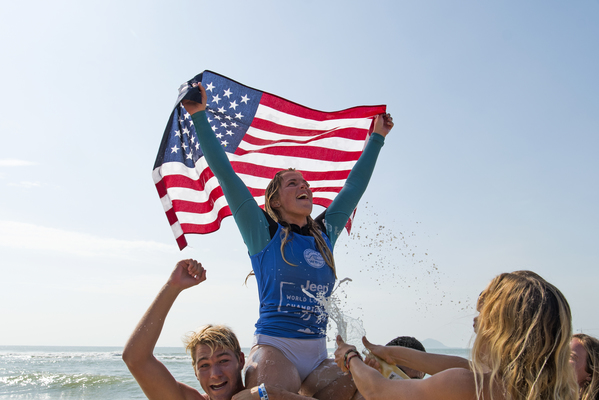By Phil Jarratt
THE World Surf League’s Jeep World Longboard Championships, which concluded on the long-lining lefts of Riyue Bay, Hainan Island, China, last weekend, not only crowned two new world champions but opened up a renewed debate around the world about what constitutes good longboarding.
The argument about traditional versus performance or progressive longboarding approaches has been around since I was merely middle-aged, but it seems that everyone still has an opinion and the matter is no closer to resolution than it’s ever been.
What ignited this latest round of debate was the fact that in the early rounds of the event in China, the WSL judges appeared to have made a significant shift in favour of the traditional style. The most blatant example of this was the round one victory of California’s 18-year-old Kevin Skvarna over two-times world champion Taylor Jensen.
Jensen wasn’t at his powerhouse best, but a couple of his solid rides seemed underscored while the California kid was getting nines for smooth trims and extended nose-rides. That simply wouldn’t have happened at the same event last year, when Peru’s Piccolo Clemente beat Jensen in a final of high performance lip-bashing. So the WSL had finally taken note of the logger movement which has been gaining momentum for almost a decade wherever there are point break waves to be ridden. Or had they?
As the world titles went on, the traditionalists started to fall by the wayside as the best and most savvy progressives, like Jensen, Brazil’s Phil Rajzman and Australia’s Harley Ingleby (all of whom have won world titles), and California’s Tory Gilkerson in the women’s, put on their smooth and flowing hats to collar the points.
And, as much as I favour the truly traditional style, some of the traditionalists didn’t do themselves any favours.
New sensation Kevin Skvarna, while always pretty to watch, turned out to have a pretty lame drop-knee cutback when you analysed it, while Brazil’s Chloe Calmon – one of my favourite women surfers of the moment – simply peaked too early.
If the judges had a new direction at the start, by the time the championships got to the pointy end, they had certainly modified it, as astute observers began to note on social media. I weighed in pretty early, noting on my Facebook page that on the evidence of Jensen versus Skvarna, flow was scoring higher than power. I had no idea what this would unleash!
Former Australian and Noosa Pro champion Jason Blewitt was one of the first to wonder if the judges could keep it up: “Not too be sceptical but let’s see it stay consistent right through.” This turned out to be very astute.
Within 24 hours the thread ran around the block, with several of longboarding’s biggest names taking potshots across the cyber-bow. Uber-traditionalist Joel Tudor – probably buoyed by the fact that the online edition of Surfer Magazine had just devoted a huge amount of space to an article proclaiming Tudor’s traditional Duct Tape Invitational as the true world championships of longboarding, and asked the question, “Why are we still crowning world longboard champions on oversized thrusters?” – weighed in with some typically forthright comments, among them: “I’ve volunteered to help (the WSL) many times – it’s their own fault if they don’t want to listen – the DTI will continue to be the place where our industry looks for talent to rep its brands – I’m doing this for the next generation to have the same opportunities that were available to me!”
This was a little bit rich, seeing that the Duct Tape is an invitational and Joel hand-picks his personal favourites to compete. Event commentator Wingnut Weaver quickly put down his microphone and picked up his smart phone to respond: “Love to have your input going forward!”
As it turned out, none of the true traditionalists made it as far as the quarters in the men’s event, although both of the women’s finalists, Chloe Calmon and new world champion Tory Gilkerson, definitely have the silky smooth elements of the old school in their repertoires.
In the men’s final it was interesting to see Brazil’s Phil Rajzman, who won his last world title entirely on high performance, adapt an old-school drop-knee turn and walk combo to get the better of South Africa’s Stephen Sawyer.
So the message from the judging tower seems to be – we’ve moved a little bit from power to flow, but you still need to mix it up to win WSL longboard events.
Mono goes for gold in La Jolla
Meanwhile, in a tiny winter shorebreak at La Jolla Shores north of San Diego, Mark “Mono” Stewart made it two world titles in succession, combo-ing the field to take out the stance divisions of the ISA World Adaptive Surfing Championships.
You’d have to paddle a long way to find a more courageous bloke and better ambassador for surfing than the veteran from Byron Bay, but at the world adaptives, Mono was not the only hero. I switched on the webcast on Monday morning and caught the impressive second half of the final, but what brought a tear to my eye was the sight of Mono being chaired up the beach by a team-mate struggling in soft sand on two prosthetic legs, and not giving up.
These guys have got the stoke in spades. We hope to have Mono Stewart back in March as a special guest at the Laguna Real Estate Noosa Festival of Surfing.









